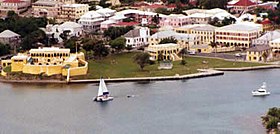Christiansted
| Christiansted, U.S. Virgin Islands | |
|---|---|
| Town | |
| Town of Christiansted | |

Aerial view of Christiansted
|
|
| Country |
|
| Territory |
|
| Island | Saint Croix |
| Established | September 1, 1734 |
| Population (2004) | |
| • Total | 3,000 |
Christiansted, U.S. Virgin Islands is the largest town on Saint Croix, one of the main islands comprising the United States Virgin Islands, a territory of the United States of America. It is a former capital of the Danish West Indies and home to the Christiansted National Historic Site. Christiansted as of 2004, had a population of about 3,000. The 2000 census population of the town was 2,637; that of the larger sub-district was 2,865.
The town was founded by Frederick Moth after he was made governor of St.Croix in 1733. Departing from St. Thomas, Capt. Moth's party had cleared a space for Fort Christianswaern by 5 Sept. In a ceremony next to this fort on 8 Jan. 1734, the French formally handed over the island to the Danes in the form of the Danish West India and Guinea Company. The island was to be allotted 300 plantations, 215 for sugar and the remainder for cotton. The plantations surveyed were 3000 feet by 2000 feet. In addition, the company established a sugar refinery and distillery. The fort was completed by 1740. The 1742 census listed 120 sugar plantations, 122 cotton plantations, and 1906 slaves compared to about 300 Englishmen and 60 Danes. By 1743 the island had a hospital and in 1745, the number of slaves had increased to 2878. By 1754, the town included 83 "white inhabitants", "each of whom owned from a single slave to sixty-six of them," according the Westergaard. Total slaves on the island had increased to 7566.
Christiansted has preserved the 18th-century Danish-style buildings constructed by African slaves. Solid stone buildings in pastel colors with bright red tile roofs line the cobblestone sidewalks, adding a touch of 18th-century European architectural style. Because the town was constructed by African slaves, there are many African influences in Christiansted's design as well, making it one of the few "African-Danish" towns in the world. The town's symmetry, with streets running at right angles to the waterfront, makes it popular for walking tours. The commercial area centers on King and Company streets, adjacent to the Christiansted National Historic Site. The residential area, including portions that were originally settlements for free blacks, extends inland and uphill from the commercial area.
...
Wikipedia
